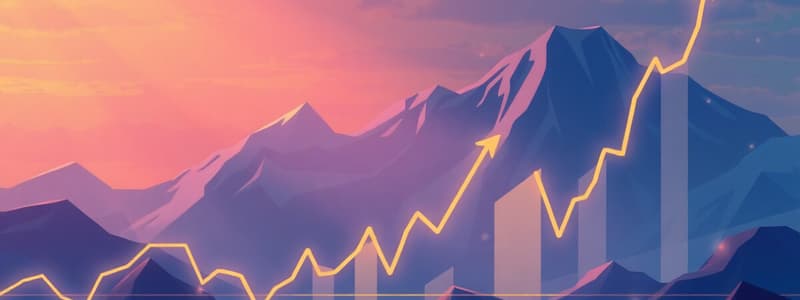Podcast
Questions and Answers
Which economic indicator best represents a country’s overall economic activity?
Which economic indicator best represents a country’s overall economic activity?
- Unemployment rate
- Consumer price index
- Gross domestic product (GDP) (correct)
- Price indices
What does the Consumer Price Index (CPI) measure?
What does the Consumer Price Index (CPI) measure?
- The total number of unemployed individuals
- The growth rate of GDP
- The purchasing power of consumers (correct)
- The market value of exports and imports
Which of the following statements about the unemployment rate is true?
Which of the following statements about the unemployment rate is true?
- It includes seasonal and cyclical adjustments
- It is calculated based on workers above 16 who are not employed (correct)
- It measures all individuals not working regardless of age
- It is not useful for government planning purposes
Which company is NOT typically associated with the sharing economy?
Which company is NOT typically associated with the sharing economy?
What is the primary purpose of the sharing economy?
What is the primary purpose of the sharing economy?
What distinguishes privately held organizations from publicly traded ones?
What distinguishes privately held organizations from publicly traded ones?
What is the primary focus of the nonprofit sector?
What is the primary focus of the nonprofit sector?
Which management function involves defining goals and establishing strategies?
Which management function involves defining goals and establishing strategies?
What is the role of civil servants in the public sector?
What is the role of civil servants in the public sector?
Which of the following best describes the concept of 'universality of management'?
Which of the following best describes the concept of 'universality of management'?
Which skill involves a manager's capability to analyze complex situations?
Which skill involves a manager's capability to analyze complex situations?
What aspect of leadership is associated with motivating and directing subordinates?
What aspect of leadership is associated with motivating and directing subordinates?
Which function of management involves monitoring actual performance and taking corrective action?
Which function of management involves monitoring actual performance and taking corrective action?
What is the primary goal of global sourcing for organizations?
What is the primary goal of global sourcing for organizations?
Which type of organization decentralizes management and decisions to local levels in each country?
Which type of organization decentralizes management and decisions to local levels in each country?
What factor significantly impacts talent globalization in organizations?
What factor significantly impacts talent globalization in organizations?
What is a defining characteristic of a transnational (borderless) organization?
What is a defining characteristic of a transnational (borderless) organization?
How can organizations be considered global in terms of financial resources?
How can organizations be considered global in terms of financial resources?
What often characterizes the initial stage of an organization going global?
What often characterizes the initial stage of an organization going global?
Which type of organization treats the world market as an integrated whole?
Which type of organization treats the world market as an integrated whole?
What is the impact of a global economic slowdown on organizations?
What is the impact of a global economic slowdown on organizations?
What distinguishes a policy from a rule in decision making?
What distinguishes a policy from a rule in decision making?
What characterizes nonprogrammed decisions?
What characterizes nonprogrammed decisions?
Under which decision-making condition is there complete certainty about outcomes?
Under which decision-making condition is there complete certainty about outcomes?
What approach would a pessimistic manager likely follow under uncertainty?
What approach would a pessimistic manager likely follow under uncertainty?
Which of these is an advantage of group decision-making?
Which of these is an advantage of group decision-making?
What is a possible disadvantage of group decision-making?
What is a possible disadvantage of group decision-making?
What is a major benefit of planning within an organization?
What is a major benefit of planning within an organization?
What is necessary when facing an unstructured problem?
What is necessary when facing an unstructured problem?
Which condition is most commonly faced by managers in decision-making?
Which condition is most commonly faced by managers in decision-making?
How does planning facilitate control in an organization?
How does planning facilitate control in an organization?
Which of the following is a criticism of formal planning?
Which of the following is a criticism of formal planning?
Which choice reflects a manager's desire to minimize potential regret?
Which choice reflects a manager's desire to minimize potential regret?
What limitation is associated with formal planning?
What limitation is associated with formal planning?
What is a common characteristic of group decision-making?
What is a common characteristic of group decision-making?
What is typically true about organizations that engage in formal planning?
What is typically true about organizations that engage in formal planning?
What is a characteristic of informal planning?
What is a characteristic of informal planning?
Why is planning considered the primary management function?
Why is planning considered the primary management function?
Which of the following defines effective plans?
Which of the following defines effective plans?
How does planning reduce uncertainty for organizations?
How does planning reduce uncertainty for organizations?
What differentiates formal planning from informal planning?
What differentiates formal planning from informal planning?
Which of the following is NOT a benefit of planning?
Which of the following is NOT a benefit of planning?
In what type of organizations is informal planning more commonly found?
In what type of organizations is informal planning more commonly found?
What is an essential aspect of developing a specific action program in formal planning?
What is an essential aspect of developing a specific action program in formal planning?
Flashcards
Privately Held Organizations
Privately Held Organizations
Companies whose shares aren't traded on a stock exchange.
Nonprofit Sector
Nonprofit Sector
Part of the economy where organizations aim for purposes beyond profit (e.g., charity, services).
Management Functions
Management Functions
These include planning, organizing, leading, and controlling.
Planning (Management)
Planning (Management)
Signup and view all the flashcards
Organizing (Management)
Organizing (Management)
Signup and view all the flashcards
Leading (Management)
Leading (Management)
Signup and view all the flashcards
Controlling (Management)
Controlling (Management)
Signup and view all the flashcards
Management Skills (General)
Management Skills (General)
Signup and view all the flashcards
GDP
GDP
Signup and view all the flashcards
CPI
CPI
Signup and view all the flashcards
Unemployment Rate
Unemployment Rate
Signup and view all the flashcards
Sharing Economy
Sharing Economy
Signup and view all the flashcards
Impact of Economic Conditions on Management
Impact of Economic Conditions on Management
Signup and view all the flashcards
Global Sourcing
Global Sourcing
Signup and view all the flashcards
Multidomestic Corporation
Multidomestic Corporation
Signup and view all the flashcards
Why do companies become global?
Why do companies become global?
Signup and view all the flashcards
Global Corporation
Global Corporation
Signup and view all the flashcards
Transnational Organization (TNC)
Transnational Organization (TNC)
Signup and view all the flashcards
What is Financial Globalization?
What is Financial Globalization?
Signup and view all the flashcards
What is Talent Globalization?
What is Talent Globalization?
Signup and view all the flashcards
Multinational Corporation (MNC)
Multinational Corporation (MNC)
Signup and view all the flashcards
Planning Reduces Waste
Planning Reduces Waste
Signup and view all the flashcards
Planning clarifies Goals
Planning clarifies Goals
Signup and view all the flashcards
Does Planning Impact Performance?
Does Planning Impact Performance?
Signup and view all the flashcards
Planning's Downside: Rigidity
Planning's Downside: Rigidity
Signup and view all the flashcards
Planning vs. Creativity
Planning vs. Creativity
Signup and view all the flashcards
Policy vs. Rule
Policy vs. Rule
Signup and view all the flashcards
Nonprogrammed Decision
Nonprogrammed Decision
Signup and view all the flashcards
Decision-Making Conditions
Decision-Making Conditions
Signup and view all the flashcards
Certainty (Decision-Making)
Certainty (Decision-Making)
Signup and view all the flashcards
Risk (Decision-Making)
Risk (Decision-Making)
Signup and view all the flashcards
Uncertainty (Decision-Making)
Uncertainty (Decision-Making)
Signup and view all the flashcards
Maximax Choice
Maximax Choice
Signup and view all the flashcards
Maximin Choice
Maximin Choice
Signup and view all the flashcards
Minimax Choice
Minimax Choice
Signup and view all the flashcards
Group Decision Making: Advantages
Group Decision Making: Advantages
Signup and view all the flashcards
Formal Planning
Formal Planning
Signup and view all the flashcards
Informal Planning
Informal Planning
Signup and view all the flashcards
Planning: Key Functions
Planning: Key Functions
Signup and view all the flashcards
Planning: Provides Direction
Planning: Provides Direction
Signup and view all the flashcards
Planning: Reduces Uncertainty
Planning: Reduces Uncertainty
Signup and view all the flashcards
Planning: Facilitates Change
Planning: Facilitates Change
Signup and view all the flashcards
Effective Planning Characteristics
Effective Planning Characteristics
Signup and view all the flashcards
Why is Planning the Primary Function?
Why is Planning the Primary Function?
Signup and view all the flashcards
Study Notes
No specific topic provided. Please provide the text or questions.
Studying That Suits You
Use AI to generate personalized quizzes and flashcards to suit your learning preferences.




